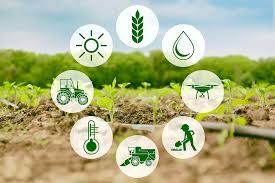
Agriculture has long been the backbone of India’s economy, providing livelihood to nearly half of its population and serving as a critical pillar for food security. Despite its historical importance, the sector faces numerous challenges, including climate change, land degradation, water scarcity, and a rising demand for food due to population growth. In this context, "navigating the future of agriculture" becomes not just a goal but a necessity to ensure sustainable growth and prosperity for millions of farmers and consumers alike.
Current Landscape of Indian Agriculture
India is one of the largest producers of essential commodities like rice, wheat, pulses, and spices. However, the sector’s growth has been uneven, with smallholder farmers often struggling to cope with inefficiencies, outdated practices, and market fluctuations.
Key issues such as fragmented land holdings, low mechanization, and inadequate access to credit and technology have hindered productivity. The agrarian distress is further aggravated by erratic rainfall patterns, rising input costs, and limited market access for small farmers.
Challenges Shaping the Future
-
Climate Change and Environmental Stress:
India is highly vulnerable to climate change, with rising temperatures, unpredictable monsoons, and an increasing frequency of extreme weather events. These factors directly impact crop yields and the overall resilience of the agricultural system. -
Water Scarcity:
Agriculture accounts for over 80% of the nation’s water usage, but inefficient irrigation practices lead to wastage. With depleting groundwater levels, ensuring sustainable water management is imperative. -
Youth Migration and Workforce Decline:
Many young people are leaving rural areas in search of better opportunities, leaving agriculture to an aging population. This demographic shift may reduce the adaptability of the sector to modern practices. -
Market Linkages and Price Realization:
Farmers often face challenges in selling their produce at fair prices due to inadequate storage facilities, a lack of direct market access, and limited bargaining power.
Opportunities for Transformation
Despite these challenges, there are significant opportunities to reshape the future of Indian agriculture. By leveraging technology, policy reforms, and community involvement, India can build a resilient and thriving agricultural sector.
-
Technological Integration:
- Precision Farming: Using data-driven techniques, such as satellite imagery and IoT devices, to optimize water usage, monitor crop health, and increase yields.
- Digital Platforms: Apps and portals are bridging the gap between farmers and markets, enabling better price discovery and reducing middlemen.
- Artificial Intelligence: AI-powered solutions can forecast weather, predict pest outbreaks, and recommend best farming practices.
-
Diversification and Sustainable Practices:
Encouraging crop diversification, organic farming, and agroforestry can enhance soil health and provide farmers with alternative income streams. Conservation agriculture, which minimizes soil disturbance, can also improve productivity while being environmentally friendly. -
Policy and Financial Support:
Government schemes like PM-Kisan and eNAM have started to make an impact, but expanding their reach and effectiveness will be crucial. Providing affordable credit, crop insurance, and subsidies for adopting green technologies can significantly empower farmers. -
Strengthening Farmer Cooperatives:
By organizing farmers into cooperatives or Farmer Producer Organizations (FPOs), they can gain access to collective bargaining power, better storage facilities, and market linkages.
A Vision for the Future
The future of agriculture in India lies in the seamless integration of tradition and innovation. Traditional practices rooted in indigenous knowledge should be complemented by modern technologies and scientific advancements. Furthermore, policies must be farmer-centric, focusing on creating sustainable livelihoods rather than short-term solutions.
Navigating the future of agriculture requires a holistic approach where stakeholders—farmers, scientists, policymakers, and the private sector—collaborate toward common goals. Empowering women in agriculture, fostering youth involvement, and promoting community participation will ensure inclusivity and equitable growth.
Conclusion
India stands at a crossroads in its agricultural journey. With the right interventions, the sector can become a model of sustainability and innovation, not just for the nation but for the world. The path forward involves tackling challenges head-on while embracing opportunities for growth. By prioritizing resilience, inclusivity, and efficiency, India can truly navigate the future of agriculture and ensure a prosperous future for its people and the planet.

0 Comments
Post Comment